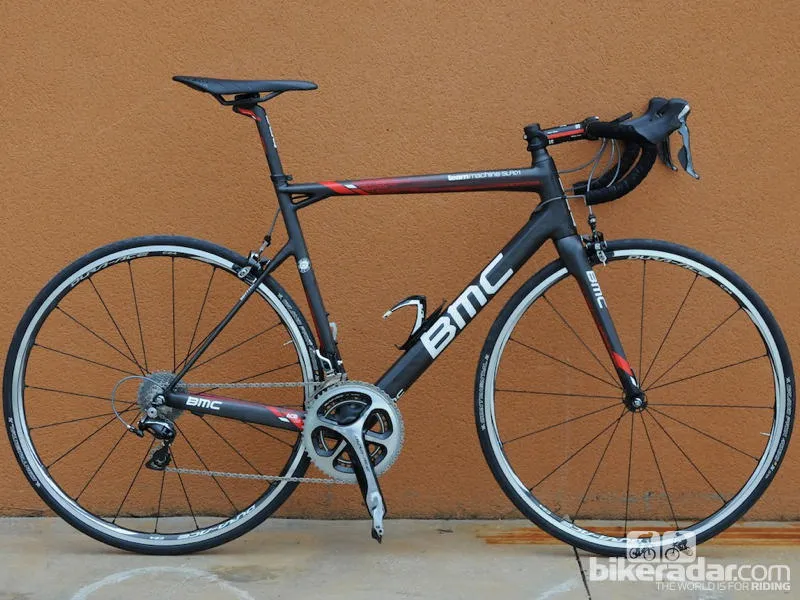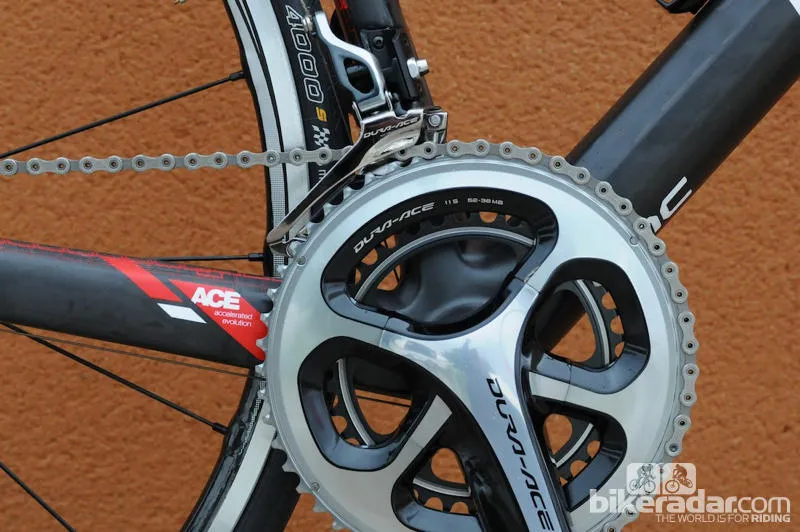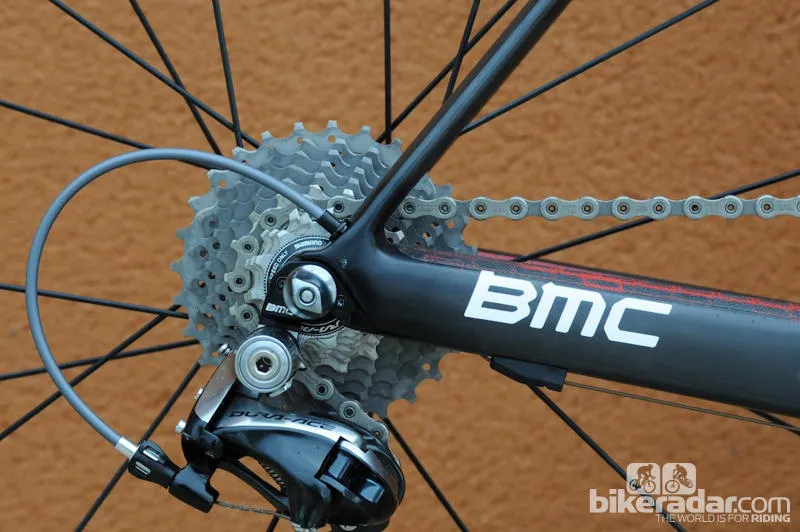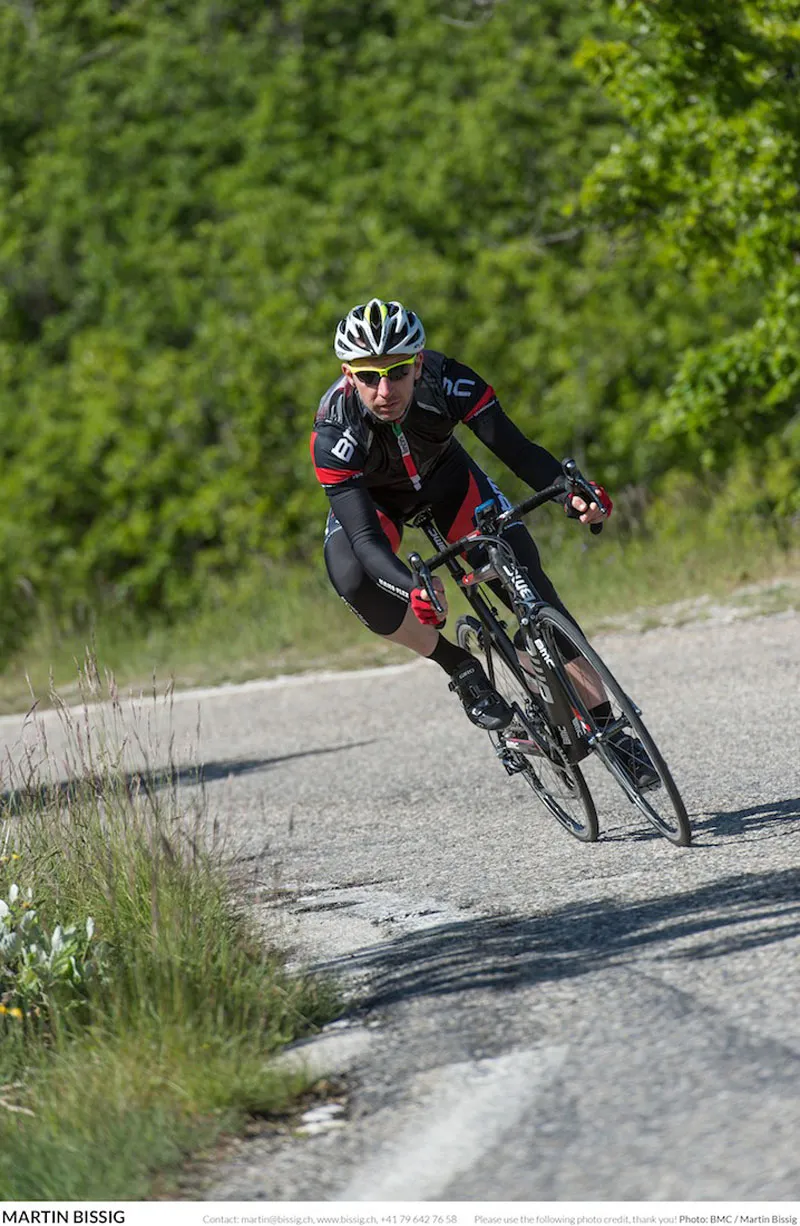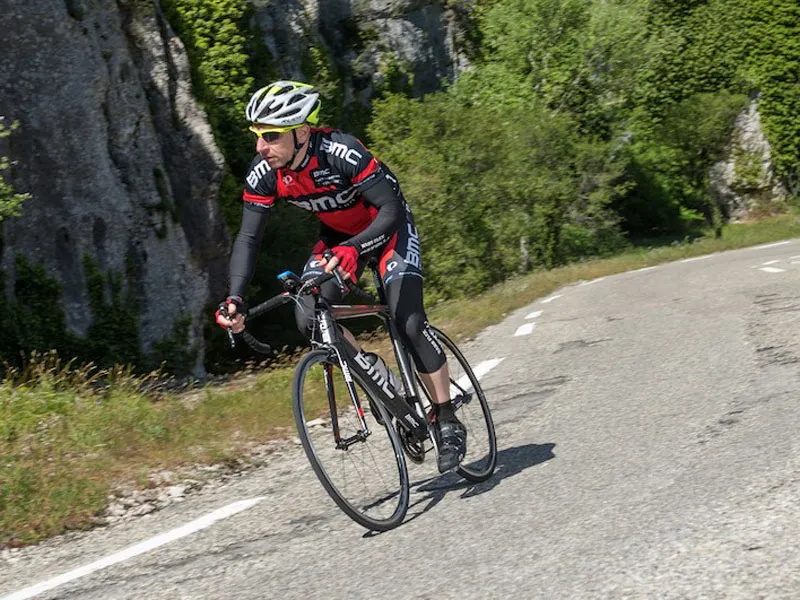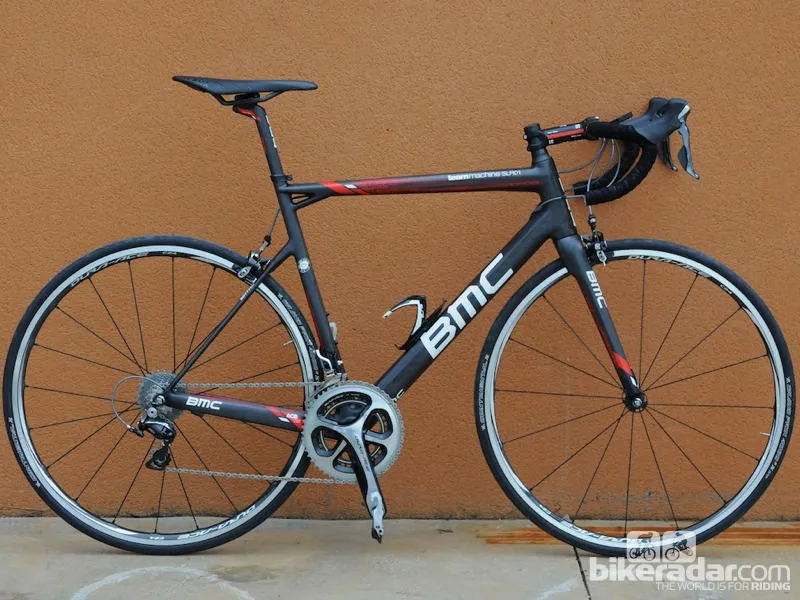The all-new BMC TeamMachine SLR01 was launched earlier this week and carries the tagline “Acceleration Redefined”, which got us wondering – is that just snappy marketing, or something we’ll actually feel out on the road?
Setting out on a cool but sunny Provence morning with a group of journalists and BMC staff, we felt it. The thing is, it wasn’t some subtle nuance that arguably only an experienced rider would feel – it was right there, hitting us square between the eyes.
Imagine taut elastic – a catapult or slingshot, or a child’s bouncy ball. Well, the SLR01 feels as though it has potential energy on tap, and any acceleration releases it in waves of kinetic energy, firing you forwards.
It’s noticeable anywhere, in any gear, but most of all when you’re climbing – at slower speeds it’s almost like a kick in the backside. Comparing climbing ability between road bikes is a largely subjective science, as there are a huge number of variables. But from the 2.5 hours we spent on the SLR01, we’re sure that it climbs like nothing else we’ve ridden.
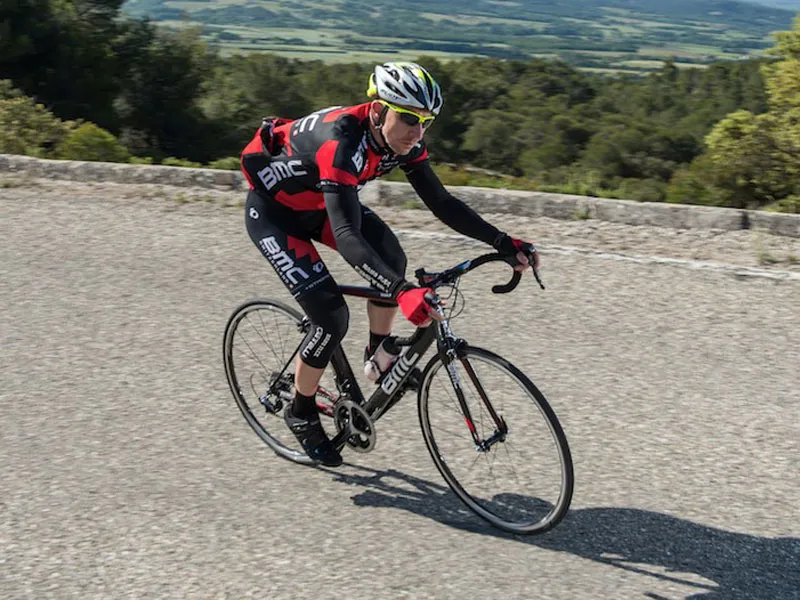
Testing the BMC TeamMachine SLR01 in Provence, France
As our test ride progressed, we were impressed with just how easy the SLR01 was to ride – it has no vices. In close-company group riding it was relaxed and stable, but with cat-like reactions when needed, to flick around or over a pothole. The increased power of the new Shimano Dura-Ace 9000 brake calipers didn’t upset the handling, the fork resisting flex in all scenarios and tracking perfectly out of the saddle.
While not encroaching on aero bike territory, the response and acceleration of the bike was superb for attacking efforts. At one point we crossed a 200m gap between groups at a maximum of 38mph, the frame’s efficiency helping us sustain high speeds with less perceived effort than we’d expect.
Descending was a strongpoint of the previous model, and the new bike builds on that. On a very technical descent with countless blind hairpins, rough surfaces and varying cambers, it was easy to place the SLR01 precisely where we needed it to be. Late braking or mid-corner line changes didn’t fluster it one bit, and carving smooth lines while maintaining speed was simple as the bike gives such confidence.
What’s really surprising, though, is just how cosseting the ride quality is. Stiff, responsive bikes and armchair comfort are usually mutually exclusive, but the SLR01 manages to combine them into a true Grand Tour challenger.
Taking a line through the sort of crumbling road that would normally have us calling the dentist and chiropractor, the frame just sucked it up – sure, it was firm, but not bone-shaking. Whether you’re a rouleur, a climber or a puncheur, the SLR01 is a superbly rounded machine, and the acceleration is so infectious we just couldn’t help ourselves testing it again and again.
Frame tech: Stiffer, lighter, better
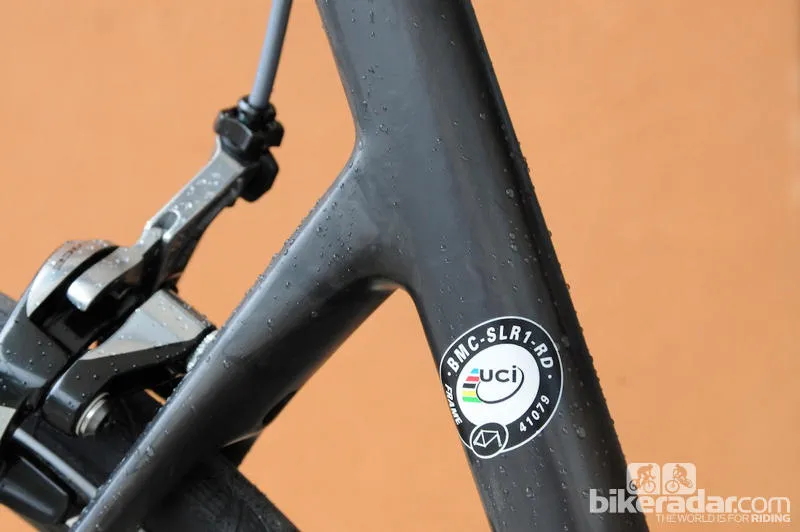
The TeamMachine SLR01 is UCI approved
BMC’s road bike sectors put the SLR01, appropriately, as head of the Altitude Series. Then there’s the Endurance Series for the GranFondo (GF) machines, and the Aero Series for the TM (TimeMachine) and TMR (TimeMachine Race) models.
So it accelerates like Usain Bolt running downhill with a tail wind, but why? BMC say the new SLR01 frame is almost 15 percent lighter than its predecessor, but with 25 percent greater torsional stiffness, 10 percent more bottom bracket stiffness and 10 percent more vertical compliance.
But, as we know, a stiff frame isn’t necessarily faster. The figures mean the new bike is even stiffer than the GF01, and close behind the brutally efficient TMR01, with vertical compliance figures at around 70 percent of the springy GF01 and almost three times those of the TMR01.
This brings us back to the ACE (Accelerated Composites Evolution) software developed by BMC and ETH University in Zurich. Once the specification and performance wishlist, physical parameters and material options were programmed, a computer generated a frame design, then simulated its performance and refined and adjusted the blueprints.
Each design-generating process was one iteration, and in the 360 days it took to reach the final form of the SLR01, the computer logged 34,000 variations. The benefits of such advanced software are the savings on physical prototype constructions, and highly accelerated development.
The frame shaping is focused on the oversized down tube, whose surface area comprises about 30 percent of the frame’s total. A new carbon layup allows lighter and thinner carbon sections to be the stiffest, and while a normal frame includes 200 to 300 carbon sheets in its construction, the new frame has around 400 much thinner sheets and uses a new manufacturing method.
The down tube makes the most of the extra width afforded by the BB86 bottom bracket shell, and offers a frame compatible with all current BBs.
The wider bottom bracket also makes room for the beefy, asymmetric chainstays, which are much wider on the non-driveside to counteract pedalling forces and maintain efficient energy transfer.
BMC continue with their dropped seatstays, which are slim, for increased compliance, but leave the seat tube area cantilevered and supported less at the rear. This promotes much more seated comfort through flex.
The top tube has an evolution of the Crosslock brace, to strengthen its junction with the seat tube. The top tube flares towards the head tube for ultimate rigidity. It's actually wider here than the down tube, meaning the head tube follows suit, but together with the stepless steerer fork it equates to a totally solid front end.
As mentioned, the result is exceptionally light, to the point where Cadel Evans' bike for the Giro d’Italia – although already specced with an SRM crank, Shimano Dura-Ace Di2 groupset, bottle cages, pedals and varying wheels – needed extra weights bolted below the seat tube bottle cage to satisfy the UCI’s minimum weight limit.
Either 50g, 100g or 250g could be added. And when you consider that 250g is almost one third of the frame weight, this seems ridiculous for a frame that exceeds EN safety tests by 20 percent.
Pro testing

Cadel Evans (3rd in the Giro d'Italia) gives his thoughts on the TeamMachine SLR01
Once the new frame was built, BMC called on their expert testers to give feedback and evaluate the bike in the real world. Cadel Evans, Tejay van Garderen and Philippe Gilbert all rode frames with yellow or red graphics in a blind test.
The frames had different carbon layups, so differing stiffness, and the riders rode a circuit devised by Evans on each bike. They then used every combination of frame, fork and seatpost to gauge their opinions.
Cadel Evans attended the Provence launch, telling us he’d first tested the new bike at the end of January, and always prefers not to be told what to expect from but to figure it out for himself using his experience.
He said he could feel the acceleration difference in the first 10-15m, but that some of his first comments were about comfort and durability. He explained this by saying his speciality is staying competitive over three weeks, rather than for a maximal effort at the end of one day – for that reason, comfort is important.
But the increased compliance also helps traction and road holding, through BMC’s Tuned Compliance Concept (TCC), optimising the balance of stiffness and comfort to prevent the bike skipping across the surface and compromising control.
As Cadel and Tejay have had initial successes with the new bike, the team will be using it at the Dauphine and Tour de Suisse, with the final team version appearing at the Tour de France.
The SLR01 as tested, with a Dura-Ace mechanical groupset, will be available in the shops in major markets in the first two weeks of the Tour de France, with other versions to follow.
Crucially, every SLR01 frame sold, no matter what the specification or intended rider, will be identical in terms of construction, meaning you can truly ride a pro-spec bike.
Six sizes, four specs
There will be six frame sizes (48, 51, 54, 56, 58 and 61cm), two seatpost setbacks (15 or 30mm) and four complete bike specs (or frameset only), although the frameset is priced to make the complete bike price more attractive. Prices at the moment are in US dollars and Euros only, with UK prices yet to be announced:
- Shimano Dura-Ace Di2, £8,500/US$12,999/€9,999, 6.25kg (13.78lb)
- Shimano Dura-Ace 9000, £6,000/US$9,999/€6,999, 6.39kg (14.09lb)
- SRAM Red 22, £5,000/US$7,999/€5,999, 6.55kg (14.44lb)
- Shimano Ultegra, £4,000/US$5,599/€3,999, 7.05kg (15.54lb)
- Frameset, £2,750/US$4,999/€3,599, 1.38kg (3.04lb)
